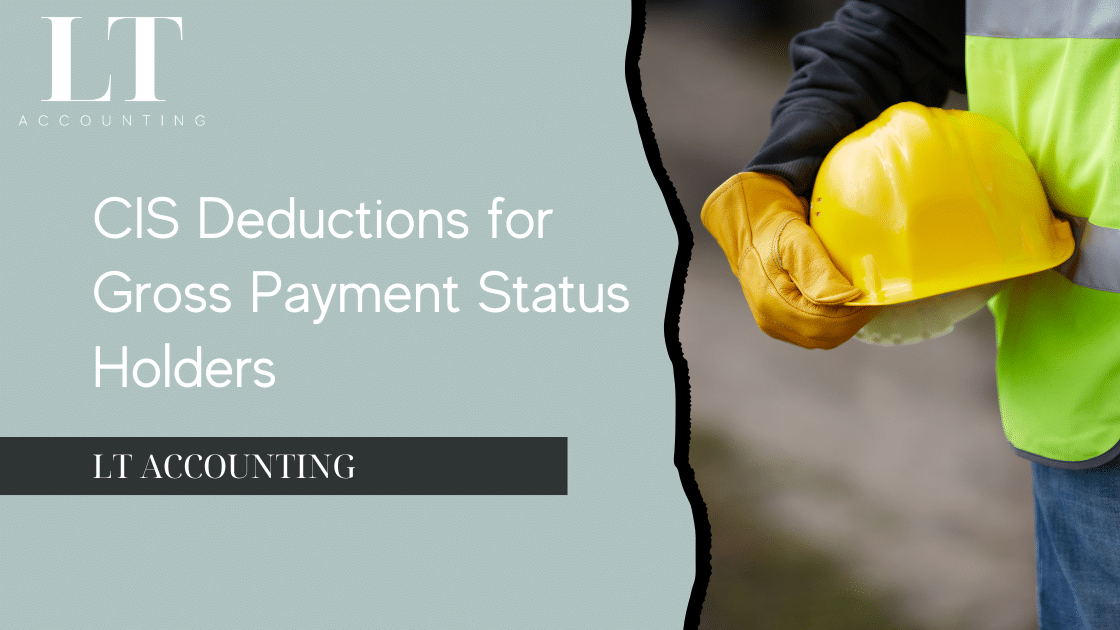If you’re working in the UK construction industry as a subcontractor, chances are you’re already familiar with the Construction Industry Scheme (CIS)—and the frustrations that can come with it. Among the most common issues faced is CIS over-deductions, where more tax is withheld than necessary, impacting your cash flow and profitability.
For subcontractors, this problem can feel like an unnecessary hit to already tight margins. And for contractors, mishandling deductions can lead to compliance issues and strained subcontractor relationships. Whether caused by administrative oversight, miscommunication, or registration errors, over-deductions are not just inconvenient—they’re avoidable.
In this article, we’ll break down:
-
How CIS deductions are supposed to work
-
Why over-deductions happen
-
How you can proactively avoid them
-
And how LT Accounting can help you stay compliant while keeping more of your earnings
Understanding the details of CIS and ensuring accurate deductions is critical, not just for tax purposes, but for the financial health of your business. Let’s start with the fundamentals.
Understanding How CIS Deductions Work
The Construction Industry Scheme (CIS) is a tax scheme introduced by HMRC to reduce tax evasion in the construction sector. It applies to contractors and subcontractors in mainstream construction work. Under CIS, contractors are required to deduct tax at source from payments made to subcontractors and then pay that deduction directly to HMRC.
Who the Scheme Applies To
-
Contractors: Businesses or individuals who pay subcontractors for construction work.
-
Subcontractors: Those who perform construction services under contract for a contractor.
Construction work includes tasks such as site preparation, demolition, building work, repairs, and installations. If you’re in any of these trades, you’re almost certainly within CIS’s scope.
Deduction Rates
The amount a contractor deducts depends on the subcontractor’s CIS registration status:
-
20% – Standard deduction rate for registered subcontractors.
-
30% – Applied to subcontractors who are not registered with CIS.
-
0% – For subcontractors granted Gross Payment Status (GPS), meaning they receive payments without deductions.
Gross Payment Status can be granted by HMRC if a subcontractor passes certain tests, such as turnover thresholds and compliance history.
How the Deduction Process Works
-
Verification: Before paying a new subcontractor, the contractor must verify their CIS status with HMRC. HMRC then confirms the deduction rate to be applied.
-
Monthly Returns: Contractors must file monthly CIS returns to HMRC, detailing all payments and deductions made.
-
Payment Statements: Contractors are required to provide payment and deduction statements to each subcontractor, showing the amounts withheld and paid to HMRC on their behalf.
This system is designed to ensure that tax liabilities are met as the income is earned. However, due to its administrative complexity, it’s all too easy for errors to slip in—leading to over-deductions that tie up your income unnecessarily.
In the next section, we’ll look at the most common reasons why over-deductions happen, so you can understand where the system might be failing you and how to fix it before it becomes a bigger issue.
Top Reasons for CIS Over-Deductions
Understanding how CIS deductions are intended to work is only part of the equation. In practice, many subcontractors find themselves losing out due to over-deductions—where more tax is withheld than necessary. This can create immediate cash flow problems and long-term frustration when attempting to reclaim funds from HMRC.
Here are the most common reasons over-deductions occur under the Construction Industry Scheme, along with insights into how each issue arises.
1. Subcontractor Not Registered or Incorrectly Verified
This is the most frequent cause of excessive deductions. When a contractor begins working with a new subcontractor, they are required to verify their CIS status with HMRC. If the subcontractor is not registered under CIS at all, the contractor must deduct tax at the higher 30% rate, even if the subcontractor has an otherwise clean tax record.
Even if a subcontractor is registered, errors in the verification process (such as providing incorrect UTR or National Insurance numbers) can lead HMRC to return an “unmatched” result. In these cases, the contractor has no choice but to apply the 30% rate, resulting in unnecessary over-deductions.
✅ Prevention Tip: Always ensure your registration is active and your details (UTR, legal name, address) exactly match what HMRC has on file.
2. Inaccurate Classification of Work or Worker
Sometimes contractors misclassify a worker as a subcontractor when they should be treated as an employee—or vice versa. If a genuine subcontractor is treated incorrectly, deductions may be made under the wrong rules or not at all, leading to later corrections and potential overpayments.
Similarly, if non-CIS work is incorrectly included under CIS deductions (such as supply-only work), this too can result in over-deductions.
✅ Prevention Tip: Understand the distinction between employment and self-employment, and ensure only qualifying construction services are subject to CIS.
3. Outdated or Incorrect Subcontractor Details
If you change your trading name, switch from sole trader to limited company, or relocate your business without notifying HMRC, your CIS status could become out of sync. This often results in the contractor’s verification attempt defaulting to the 30% deduction rate, even if you’re otherwise fully compliant.
✅ Prevention Tip: Keep your business details fully up to date with HMRC, including changes in trading structure, addresses, or banking information.
4. Late or Inaccurate CIS Monthly Returns by the Contractor
Contractors are required to submit monthly CIS returns to HMRC, declaring all payments made and deductions withheld. If a contractor files these late or includes errors (e.g., incorrect amounts or mismatched subcontractor names), the deductions reported may not align with reality.
In such cases, subcontractors may face difficulties when trying to reclaim over-deducted tax, as the contractor’s records will not support the correct figures.
✅ Prevention Tip: Work only with contractors who are organised and compliant with CIS obligations—and keep your own records to cross-reference.
5. Duplicate Deductions or Poor Bookkeeping
Mistakes can happen in even the most well-run businesses. A payment might be reported twice, or a deduction might be accidentally applied to a gross-status subcontractor. If the contractor is managing CIS records manually or using outdated systems, the risk of over-deduction rises sharply.
✅ Prevention Tip: Use professional bookkeeping services or CIS-compliant accounting software to ensure data accuracy and reduce human error.
6. Failure to Achieve or Maintain Gross Payment Status (GPS)
Many subcontractors aim to achieve Gross Payment Status, which allows them to receive payments in full without any CIS deductions. However, failure to meet HMRC’s eligibility criteria or maintain good compliance (e.g., late tax returns or missed payments) can lead to withdrawal of GPS—often without realising until over-deductions begin.
✅ Prevention Tip: Work with an accountant to stay compliant and monitor your eligibility for gross payment status annually.
How to Prevent CIS Over-Deductions
Over-deductions under the Construction Industry Scheme are not only frustrating—they can be financially damaging. Fortunately, there are clear, actionable steps subcontractors and contractors can take to prevent these issues from arising in the first place.
Whether you’re a self-employed tradesperson or operating as a limited company subcontractor, following these best practices will significantly reduce your risk of being overtaxed and waiting months for a refund from HMRC.
Register Correctly for CIS and Check Your Status
One of the most basic, yet crucial steps is ensuring you are properly registered under the CIS. If you’re not registered, contractors are obligated to deduct at the punitive 30% rate, regardless of your actual tax liability.
✅ What to do:
-
Register for CIS as a subcontractor through HMRC. This can be done online or via your accountant.
-
Make sure you are registered under the correct legal entity—sole trader, partnership, or limited company.
-
Ask your contractor to verify you before beginning work, and confirm your status has been returned as 20% (standard) or 0% (gross payment).
Apply for Gross Payment Status (GPS)
If you’re confident in your tax compliance and have a solid turnover, consider applying for Gross Payment Status. This allows you to receive your payments in full, without any deductions being made.
✅ Eligibility criteria:
-
Construction work turnover of at least £30,000 (sole traders) or £100,000 (partnerships/companies).
-
Up-to-date tax returns and payments.
-
Operating through a UK bank account.
✅ Benefits:
-
Improved cash flow.
-
Avoidance of CIS over-deductions altogether.
-
Greater flexibility in financial planning.
LT Accounting can assess your eligibility and manage your GPS application or annual compliance review to help you maintain this valuable status.
Keep Your Details Updated with HMRC
HMRC verification depends on matching your personal or business details (name, UTR, NI/company number, etc.) to what they have on file. Even minor discrepancies can cause your status to default to the 30% rate.
✅ What to check:
-
Ensure your UTR and National Insurance (or company number) are accurate on all invoices and communications.
-
Inform HMRC of any changes in trading name, address, or business structure.
-
Notify all contractors you work with if you change entity (e.g. moving from sole trader to limited company).
Use CIS-Compliant Bookkeeping Software
Manual records are prone to human error, particularly when managing multiple contractors or complex job schedules. CIS-compliant accounting software can automatically calculate deductions, generate statements, and sync with HMRC, ensuring consistency and compliance.
✅ Recommended tools:
-
Xero with CIS module
-
QuickBooks CIS
-
FreeAgent (for limited companies)
These platforms reduce errors and help maintain clean records, which are essential if you ever need to dispute or reclaim over-deductions.
Reconcile Payments and Deduction Statements Monthly
You should be receiving monthly Payment and Deduction Statements from every contractor you work with. These outline:
-
Gross payment
-
Deduction amount
-
Net payment
-
The CIS tax paid to HMRC on your behalf
✅ What to do:
-
Keep track of each monthly statement.
-
Match it against your own records and bank statements.
-
Raise discrepancies with the contractor promptly.
This monthly habit ensures you catch any over-deductions early—before they turn into a larger issue at year-end.
Maintain Clear and Regular Communication with Contractors
Misunderstandings or lack of verification are often due to poor communication. Ensure your contractors:
-
Have all your updated CIS details
-
Verify you correctly before your first job
-
Understand your GPS status if applicable
✅ Pro Tip: Include your UTR, legal name, and confirmation of CIS registration on all invoices to make verification easier.
Work with an Accountant Who Understands CIS
A CIS-experienced accountant doesn’t just file your returns—they proactively help you minimise over-deductions, maintain compliance, and make the most of your tax position. At LT Accounting, we specialise in managing CIS processes for both subcontractors and contractors, ensuring smooth operation and better cash flow.
✅ Our services include:
-
CIS registration and verification
-
Monthly return filing
-
Reconciliation of deductions
-
Gross Payment Status support
-
Year-end tax reclaim support
Steps to Reclaim CIS Over-Deductions
Even with the best processes in place, over-deductions under CIS can still occur. The good news is that HMRC provides clear pathways for subcontractors to reclaim overpaid tax—although the process differs depending on your business structure.
In this section, we’ll break down the reclaim process for both self-employed subcontractors and limited company subcontractors, along with timelines and tips to make it as smooth as possible.
For Self-Employed Subcontractors
If you’re a sole trader working under CIS and deductions have been made from your income throughout the year, you can reclaim this tax via your Self Assessment tax return.
✅ How it works:
-
Keep your CIS deduction statements from each contractor throughout the tax year.
-
When preparing your Self Assessment return, enter your gross income and the total CIS deductions withheld.
-
HMRC will subtract your CIS deductions from your overall tax liability.
-
If you’ve overpaid (which is common), you’ll receive a refund.
🗓 When to reclaim:
-
After the tax year ends on 5 April, you can file your return from 6 April onward.
-
The sooner you file, the sooner you get refunded—typically within 2 to 4 weeks after HMRC processes your return.
🔍 Tip from LT Accounting:
Avoid delays by ensuring your CIS statements match your invoices and income records exactly. Any discrepancies may trigger a manual review by HMRC.
For Limited Company Subcontractors
If your construction business operates through a limited company, the reclaim process is different because deductions withheld by contractors are treated as advance payments toward your company’s PAYE liabilities.
✅ How it works:
-
CIS deductions are offset against your company’s PAYE liabilities, such as:
-
Employer’s National Insurance
-
Employees’ income tax
-
Student loan repayments, etc.
-
-
If the CIS deductions exceed your PAYE liability, you can apply to HMRC for a CIS refund or request it to be carried forward to the next tax month.
📝 Process:
-
Submit your EPS (Employer Payment Summary) each month through your payroll software.
-
At the end of the tax year (after 5 April), if there’s still an overpayment, you can request a refund from HMRC.
📬 How to request a refund:
-
HMRC does not automatically issue refunds for limited companies.
-
You must contact HMRC (either online or by phone) and formally request a repayment.
-
Alternatively, your accountant can submit this request on your behalf.
⏳ Timeframe:
-
Refunds can take up to 6 weeks depending on HMRC’s workload and whether your PAYE records are in order.
Supporting Documentation Needed
Whether you’re self-employed or running a limited company, make sure to keep:
-
Monthly Payment and Deduction Statements from all contractors
-
Copies of invoices sent
-
A complete record of CIS deductions for the year
Inaccurate or missing documentation is a common cause of refund delays, so keeping organised records throughout the year will save time and stress.
Common Challenges and How to Avoid Them
-
Mismatch between contractor returns and subcontractor records: Always reconcile monthly.
-
Late submission of tax returns or EPS: File promptly to avoid HMRC delays.
-
Inadequate documentation: Retain every CIS statement and maintain digital backups.
How LT Accounting Streamlines CIS Reclaims
We offer specialist support to ensure CIS over-deductions are identified and reclaimed efficiently. Here’s how we help:
-
Proactive tracking of your CIS deductions throughout the year
-
Accurate filing of Self Assessment or PAYE EPS submissions
-
Direct communication with HMRC to speed up refunds
-
Tailored advice on maintaining compliance and improving cash flow
Our goal is to help you keep more of what you earn—without unnecessary waiting or red tape.
How LT Accounting Can Help
At LT Accounting, we understand how challenging the Construction Industry Scheme (CIS) can be—especially for hardworking subcontractors trying to manage day-to-day operations while navigating HMRC rules. That’s why we offer a comprehensive CIS service, tailored to help both contractors and subcontractors stay compliant, avoid over-deductions, and keep more of their income.
Here’s how our team can support you at every stage of the CIS process.
1. Full CIS Registration and Verification Support
Getting CIS right starts with proper registration. We ensure you or your company is fully registered with HMRC for CIS, under the correct business structure, and ready to be verified without error.
✅ We assist with:
-
CIS registration for new sole traders and limited companies
-
Verification requests and responses
-
Ensuring your details match HMRC records exactly
This helps prevent the most common cause of over-deductions: incorrect or failed verification.
2. Monthly CIS Returns for Contractors
If you’re a contractor, we manage your monthly CIS return obligations, ensuring every subcontractor is properly verified and that deductions are calculated and reported accurately.
✅ Our services include:
-
Subcontractor verification with HMRC
-
Calculation of correct deduction rates (0%, 20%, 30%)
-
Submission of monthly CIS returns to HMRC
-
Preparation and distribution of Payment and Deduction Statements for subcontractors
This minimises your compliance risks and builds trust with your subcontractors by ensuring their tax is handled correctly.
3. Proactive CIS Deduction Tracking for Subcontractors
For subcontractors, we keep a detailed, up-to-date record of all CIS deductions made by your contractors throughout the tax year. This means:
-
No surprises at year-end
-
A clear view of what tax you’ve already paid
-
Faster, smoother refunds if over-deductions occur
We also help subcontractors apply for and maintain Gross Payment Status, where eligible, to eliminate deductions altogether.
4. Efficient Tax Reclaim Services
If you’ve been over-deducted, we don’t just fill out forms—we take charge of the entire reclaim process, so you don’t have to spend hours dealing with HMRC.
✅ For self-employed subcontractors:
-
Accurate preparation and early submission of your Self Assessment return
-
Fast-tracked refunds, usually within 2–4 weeks
✅ For limited companies:
-
Monthly EPS submissions through your payroll system
-
Annual PAYE reconciliation and direct refund request from HMRC
Our knowledge of HMRC systems means fewer delays and quicker resolution—putting your money back where it belongs.
5. Year-End Accounts and Self-Assessment Integration
CIS deductions don’t exist in isolation—they affect your year-end accounts, tax liabilities, and your overall business performance. LT Accounting integrates CIS management with:
-
Self Assessment tax returns
-
Limited company accounts
-
PAYE and VAT filings
By providing a joined-up service, we ensure consistency across your entire financial picture.
6. Personal, Ongoing Advice and Support
Tax and compliance issues rarely happen just once—they evolve as your business grows. We offer:
-
Ongoing advice on maintaining Gross Payment Status
-
Help transitioning from sole trader to limited company (or vice versa)
-
Strategic tax planning based on your CIS deductions and income trends
You’ll have a dedicated accountant who understands your business and the construction sector.
Why Choose LT Accounting for CIS?
-
🛠 Industry-specific knowledge – We specialise in construction sector accounting and fully understand the nuances of CIS.
-
📊 Comprehensive services – From registration to year-end reporting, we cover every aspect of your accounting.
-
🤝 Client-first approach – Whether you’re a contractor or subcontractor, we tailor our services to your business model.
-
⚡️ Quick and accurate – We don’t just help you stay compliant—we help you reclaim what you’re owed, fast.
Conclusion
CIS over-deductions are more than just a paperwork nuisance—they can significantly affect your cash flow, limit your reinvestment potential, and cause unnecessary stress when trying to reclaim funds from HMRC. The good news? These over-deductions are entirely preventable with the right systems, support, and strategic approach.
By understanding how CIS deductions work and recognising where things typically go wrong, you can take proactive steps to reduce or eliminate over-deductions altogether. Whether you’re a self-employed subcontractor or managing your own limited company, staying on top of CIS requirements—from registration and verification to bookkeeping and returns—is essential.
And you don’t have to do it alone.
💼 Work with LT Accounting
At LT Accounting, we provide specialist CIS accounting services tailored to the needs of UK construction professionals. Our dedicated team will:
-
Register and verify your CIS status correctly
-
Manage monthly returns and deduction statements
-
Track and reconcile your payments accurately
-
Handle Self Assessment or PAYE reclaim processes with HMRC
-
Offer strategic guidance to help you achieve Gross Payment Status
We’re here to simplify the CIS process and make sure you’re not overpaying tax unnecessarily. With our expertise, you’ll gain peace of mind knowing that every deduction is correct—and any reclaim is handled swiftly.
📞 Ready to Reclaim What You’re Owed?
If you’re concerned about CIS over-deductions or need help managing your construction finances, contact LT Accounting today.
➡️ Call us, email, or book a free consultation through our website to find out how we can help you stay compliant and keep more of your income.
LT Accounting – Making CIS simple, so you can focus on building.






